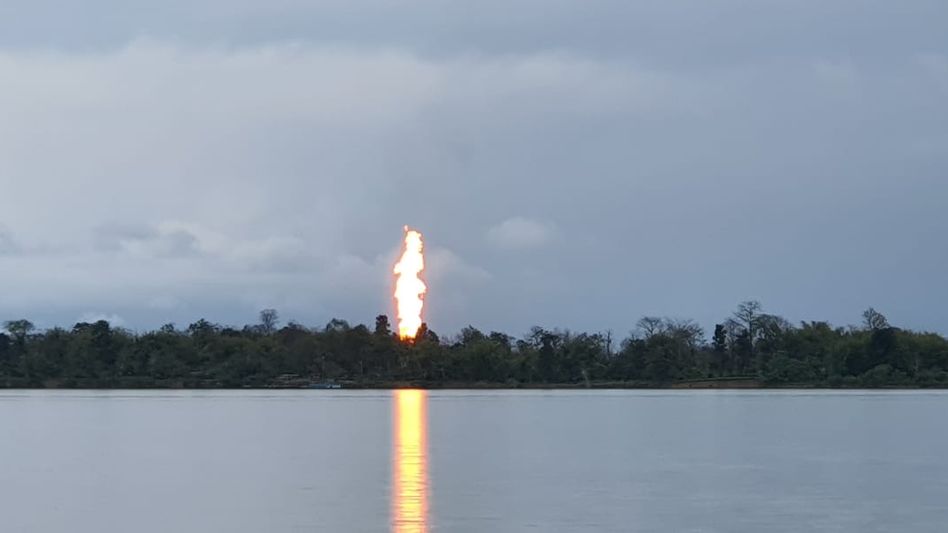What happened in Baghjan: Allegations, geopolitics and beyond the issue
 Assam: snubbing
Assam: snubbingOn 27th of May, 2020 an Oil India Limited gas well, the BGR 5, faced a blowout which spewed hydrocarbons across a huge radius raining the adjoining villages in Baghjan with associated condensate. The blowout caught fire on the 9th of June, 2020 when well control experts from M/S Alert Disaster Control had arrived at the scene to begin work on capping the well. The fire is still raging as this report is being typed out. Villagers were evacuated immediately and sheltered in nearby schools which facilitated as relief centres. Two persons, both OIL employees, have lost their lives due to the blowout.
The incident
The BGR-5 is located in the Baghjan Oilfield operated by the state PSU Oil India Limited. It was a 14-year-old producing gas well located near villages inhabited primarily by the Moran-Mottock communities of Assam. Also, the location is in an eco-sensitive zone which is very close to the Dibru Saikhowa national park as well as the Maguri Motapung Beel, both of which are spots for eco-tourism and home to numerous endemic as well as migratory species.
The incident occurred during work over operations (repair or treatment work in layman’s terms) conducted by the private service provider John Energy Limited. The job was to conduct a zone change (changing the depth from which production is done) from the producing depth at 3729m. After this, the wellhead (an apparatus at the surface on top of the well) was to be changed and for this, the well failsafe known as the Blowout Preventer (BOP) was removed. It was during this time when the well blew out. The workers had to flee the site immediately because there was no way that intervention could have been done in a 4500 psi high-pressure well. OIL immediately placed water jackets to contain the gas so as to avoid fire. One of the only three companies that conduct such well control operations, M/S Alert Disaster Control (the other two being Boots & Coots and Wild Well Control) were contacted to take charge of the situation. The well continued to expel gas as well as condensate that settled in the nearby areas for the next 13 days. The rainy weather also kept the probability of fire low. On the 9th of June, the well burst into a towering inferno. The condensate that had already spread in the neighbouring areas caught fire and this resulted in many houses, trees, small tea gardens, fauna burning to death. Two firefighters, Durlav Gogoi and Tikheswar Gohain also lost their lives in the fire that spread and engulfed the area very quickly. The film of condensate on the nearby plants and the water bodies has caused a shortage of oxygen leading to the slow death of plants as well as water animals including an endangered river dolphin.
Allegations in Baghjan
As soon as the news spread, the blame game began and people tried to draw conclusions as to who must be responsible for the debacle in Baghjan. At this point, it is important to know that the limited amount of data being released by OIL is not enough to make any concrete allegation. One of the first allegations were probably put forward by Prodip Kumar Saikia, the principal geoscientist who interpreted the initial petrophysical logs (different tests to determine the nature of a well) of the well back in 2005. Saikia said that despite his efforts to classify the well as a gas-gas condensate well, his interpretation was overridden and it was categorized as a gas well. OIL continued working on it as a gas well. Since the density, as well as the specific gravity of condensate, is much higher than that of natural gas, the precautions to be taken while working over such well is naturally much higher than those required in a gas well. Thus, a lower threshold of precaution during the operation is alleged to be one of the reasons.
Another allegation that is doing the rounds through the grapevine is that OIL didn’t allow the service providers enough time for the mandatory Wait on Cement (the time required to allow the cement to set and harden) in Baghjan. While the theoretical time for the WOC is supposed to be 48 hours, sometimes this time is reduced a little for emergency purposes. But the rumours allege that the OIL engineer only allowed for 8 hours of WOC time after which John Energy was asked to remove the pipes. Now this allegation can easily be verified by looking at the well plan. Considering the rig hire cost is quite high, two days of inactivity of the rig can only be explained by WOC time. Jonathan Bellarby in his textbook on well completion design had said, “The temptation to save time during a completion operation is false economy.” Needless to say, the one to benefit if this allegation were to be true is John Energy considering the fact that they run a risk to be blacklisted for further operations if the entire blame was to be put on them.

Miscalculation of the depth of operation is said to be another possible reason behind the Baghjan incident. According to this, the squeeze cementing operation that was intended to shut off the previous zone was not conducted at the correct interval. This is a very strong allegation considering the operation itself was for zone changing and the Casing Bond/Variable Density Logs of the well would clearly point out if this indeed was the case.
Blowouts being rare cases in themselves, mostly occur in drilling wells which have uncased open holes and are yet to produce. The most pertinent question thus is regarding the fact that how was this possible in a fourteen year old producing well which was cased and cemented with four casing policy? Considering all this, one fact is for certain; human negligence was definitely a reason behind the incident. On whose part is the real question. But as mentioned before, the data made available right now is not enough to put any kind of concrete allegations and we will have to wait for the Oil Industry Safety Directorate (OISD) report of the case.
Probable solutions of the Baghjan incident
The most plausible way of well control in this case, and probably the one considered by M/S Alert, is a textbook case of controlling such wells. The idea is to drill a relief well adjoining the previous well and connecting it to the same wellbore. The gas from the previous well will be channelled through the new well. When this is done, a controlled explosion in the previous well at a safe depth below the surface can create a vacuum thus allowing the formation to collapse upon itself and shutting the previous well.
Another process, which is more orthodox, can be the use of a rover to place the Blow Out Preventer (BOP) along with an elongated stove pipe which will act as a chimney. The fire can be channelled through the stove pipe to an elevated height while the BOP can be fixed at the well head. It is to be noted that this can only be possible if at least one of the casing hangers on the well head has not melted and is still intact in Baghjan.
Again, this is subject to well conditions and can only be determined accurately according to divulgence of data by OIL.
Environmental Effects and Mitigation: Baghjan
The adverse effects due to the blowout on the environment will of course be huge. The entire area that has faced the shower of condensate is now slowly dying off. Condensate has a very high surface tension. Because of this, it has the tendency to occupy maximum surface area in less amount of time. Thus, these hydro carbons will create a thin film over any surface that they land on. This will create troubles for the plants and riverine animals to breathe. As a result, many plants from around the area and fishes in the water bodies have withered off or died due to lack of oxygen.
Condensate is highly volatile and has a low flash point which causes it to catch fire very easily at relatively lower temperatures. Such is the case that even if a trace amount of condensate is left behind, it can get attached to a person’s body even upon limited contact and can later catch fire. Thus, the dangers involved and the mitigation techniques to be undertaken are quite high.
Due to its higher surface tension, condensate has a tendency to spread over very easily. Therefore, its presence in rivers located 3 kms away is highly alarming. This is because the flowing water of the river will further enable it to spread. However much the layer spreads, the more risk it runs to suffocate riverine animals due to absence of oxygen. In this regard, the use of oleophilic (oil loving) surfactants like those developed by scientists in IIT Guwahati might be of help.
The need is utmost for OIL to give immediate attention to strong HSE policies to be implemented in the water bodies so as to minimize impact in Baghjan. Thus, taking this into consideration, videos surfacing of Oil India Limited employees trying to soak the oil spill using gunny sacks is indeed pathetic and demands further analysis.
The Geo-Politics
Oil and Natural Gas are commodities that have the ability to change the geo political scenario of an area. This has been the case with Iraq, Venezuela, Saudi Arabia, Yemen and Assam as well. The prime issue that has cropped up after the blowout is not the tensions around how soon the well can be capped or how the ecological disturbances can be mitigated. The major discussions have been the compensation packages to be offered to the victims by the Government as well as OIL.
Lobbies and collectives have already been formed to take the lead for different demands of economic rehabilitation packages to be awarded by the government for the Baghjan episode. Some demands have already been put forward by the locals through these organizations and these demands lie somewhere between the reasonable and unreasonable.
With the elections coming up in 2021, these packages and announcements will serve as a major deciding factor and politics in the area will be carried forward along this line itself. In fact, there is a possibility that the issue of compensation grant might be dragged along till it meets its actual role of politicizing the people ahead of the elections. The ruling party made its own efforts as well. First with industries minister Chandra Mohan Patowary visiting the place and creating a mess by calling it a minor case when compared to international cases in Iran and Russia. Later the Chief Minister, Sarbananda Sonowal, visited the location in Baghjan peripheries and announced a host of benefits to be granted to the people
The National Human Rights Commision has also registered a case to investigate the incident upon the request filed by Youth’s Forum for Protection of Human Rights.
Moreover, OIL will have to spend a lot on compensatory packages. This combined with the fact that the site for cleanup is spread over large distances and condensate cleanup will need huge batches of chemical treatment brings a concern of economic instability for the company. Also, the continuous loss of pressure will affect the entire reservoir that extends over the fields of Barekuri, Makum and the adjoining areas as well. All these back breaking factors bring back questions regarding the privatization of OIL and the viability of such a step. It is worth mentioning that local organizations and student bodies have always registered their protests regarding the government’s intermittent discussions about such privatization endeavours.
Looking at the bigger picture, this incident adds on to the trend of 2020 that continues to expose the system and how the Government has continued to fail the people. Questions have been raised regarding the colonial system of education that stayed on even after independence and puts allegations on the employees of OIL to be lazy, self-centered, undeserving of the oil money and enablers of the extraction policy of the Indian state. But it needs to be understood that the OIL has been responsible for the development of quite a few oil towns as well as been employing a lot of Assamese locals.
In fact, questions need to be directed towards the functioning of the system as a whole which continued to operate along with the same colonial-era practices. Legitimate questions have been raised on the casualization of workforce on the part of the service providers hiring diploma holders to do an engineer’s job and PSUs like OIL hiring these service providers to cut corners in expenses. This is accompanied by a tendency of maintaining the status quo as opposed to taking radical decisions to make serious developments in production. The practice of the higher ups of OIL trying to maintain or increase production while compromising with well tests which demand shutting down the oil fields have also been put to court.
It also brings to fore questions regarding the validity of the very well touted Public-Private Partnership. The rumours of private service provider John Energy alleging that OIL engineers in Baghjan did not allow them sufficient time for Wait on Cement and OIL refusing such claims and the company spokesperson saying, “Why did the experienced drillers in John Energy obey such orders?” gives a clear picture of the absence of accountability on the part of both parties.
The hidden agenda?
Among all this, relief work has been undertaken by different organizations and NGOs to take care of the victims residing in the different relief camps. It is indeed a responsibility of the civil society to look after fellow humans during times of such crisis and thus these efforts must be lauded. But one such effort has faced major questioning and criticism due to the history of the social work that the group was involved in. The fundraiser from a collective of NorthEast students from an institute of national importance was among the first such efforts. But the collective’s historical involvement with the propagation of anti-Assamese narratives of Assamese xenophobia, one-dimensional support of Miya Poetry (protest poetry that claims atrocities on the part of the indigenous Assamese against Bengali Muslims) to further associations with agencies that facilitate discussions about such false and over-generalised narratives has drawn the ire of a section of the society.
It is indeed very hypocritical on the part of the collective to come forward to help the very indigenous Assamese communities whose self-determination they reject by tagging it xenophobic. Oppositions to this effort have been met by cyberbullying on the part of the people leading this initiative including extensive remarks based on personal mudslinging as well as attempts at discrediting the questioners by making below the belt remarks about caste privileges that do not factor in the debate at all.
All things considered, the blowout in Baghjan is a textbook case of oil well disasters. Discussions regarding the incident have also referred to this as the Piper Alpha of Assam. These cases help the oil and gas companies to bring in reforms in their working policy. But if that is the case, what has OIL learnt from its previous blowout in 2005 in the Dikom-15 well? Even after the Dikom blowout, the British Petroleum well blowout of Deepwater Horizon in Gulf of Mexico in 2010 is a widely publicized event with a Hollywood Movie being released with the same name. These incidents are meant to serve as lessons for oilfield professionals. But how many such lessons that claim lives must be served till perfection is attained? The answer to this question is not possible. Because even the best of measures, the best of companies, the best of professionals and the best of practices sometimes cannot keep at bay the devil that we call an oilfield blowout.
Written by Axomson. Views expressed are that of the author.
Readers like you make Inside Northeast’s work possible.
To support our brand of fearless and investigative journalism, support us HERE.
Download:
The Inside Northeast app HERE for News, Views, and Reviews from Northeast India.
Do keep following us for news on-the-go. We deliver the Northeast.
Copyright©2025 Living Media India Limited. For reprint rights: Syndications Today









